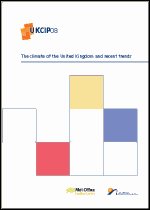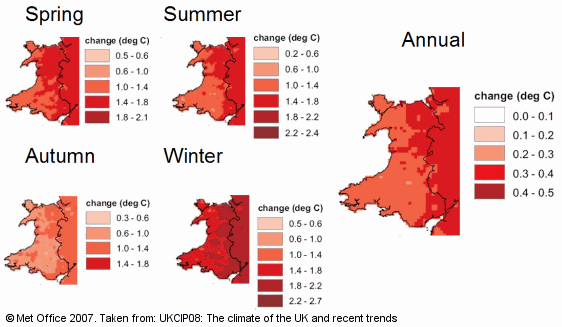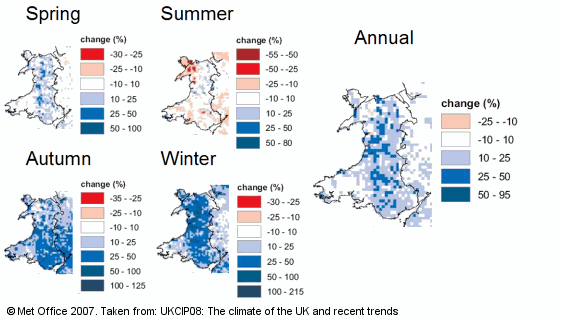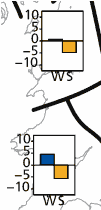Summary
Summary
- Summers will become warmer and winters will become milder
- The rainfall distribution will change, leading to drier summers, particularly in eastern and southern areas, and winters will be wetter across Wales
- Increased frequency of drought throughout Wales, and particularly in the south
- Increased frequency of high-intensity rainfall in winter leading to a greater likelihood of flooding, landslips, wetter soils, and risk of soil erosion and sedimentation of watercourses
- Less winter cold and fewer frost days
- Likely changes in wind climate, possibly with more frequent strong winds.
For a more detailed assessment of the changes in the climate of Wales between 1961 and 2004 see:
 The climate of the United Kingdom and recent trends.
The climate of the United Kingdom and recent trends.
Jenkins, G.J., Perry, M.C. & Prior, M.J.O. (2009). The climate of the United Kingdom and recent trends.
Met Office Hadley Centre, Exeter, UK.
Measured changes in selected climate variables between 1961-2006
| Spring | Summer | Autumn | Winter | Annual | |
|---|---|---|---|---|---|
| Daily mean temperature change (°C) | 1.44 | 1.36 | 1 | 1.7 | 1.33 |
| Daily maximum temperature change (°C) | 1.66 | 1.59 | 1.12 | 1.84 | 1.52 |
| Daily minimum temperature change (°C) | 1.23 | 1.18 | 0.95 | 1.56 | 1.19 |
| Mean change air frost days (number of days) | -6 | -0.2 | -2 | -12.6 | -22.4 |
| Percent change in total precipitation (%) | 8.4 | -5.6 | 22.3 | 27 | 13.6 |
| Mean change in rain days > = 1 mm (no of days) | 0.5 | -0.7 | 2.9 | 4.6 | 5.7 |
(Bold values denote significant trends at the 95% level.)
The table highlights some of the trends in climate variables across Wales between 1961-2006. There was:
- A significant increase in seasonal and annual daily mean, maximum and minimum temperature
- A significant reduction in the annual number of frost days, with a significant decrease in the number of late frosts in spring
- A trend of changing seasonal distribution of rainfall, with slightly less in the summer and more at other times, with an increase annually
- A trend of change in the number of rain days, less in the summer and more at other times, with an increase annually.

Change in seasonal and annual average daily mean temperature (°C) for Wales between 1961 and 2006 after Jenkins et al. (2007)
Changes in seasonal mean temperature over the last 40 years show a warming in all parts, but particularly in central and eastern Wales. The biggest change is during the winter months, which have become milder by as much as 2 °C in the east. Springs and summers are now generally about 1-1.5 `°C warmer across central and eastern Wales, with smaller changes in west Wales.

Change in seasonal and annual total rainfall (mm) for Wales between 1961 and 2006 after Jenkinset al. (2007)
Since 1961 there has been a slight shift in the seasonal distribution of rainfall of Wales. Trends show a slight but not significant (at the 95% level) reduction in summer rainfall, and a trend towards increased rainfall in other seasons, particularly autumn and winter. For the whole of Wales there has been a 13% increase in annual rainfall since the 1960s.

Change in the contribution of heavy rainfall events to the winter (W) and summer (S) rainfall totals of Wales, after Jenkinset al. (2007) from data provided by Tim Osborne CRU University of East Anglia.
The data show a reduction in the contribution of heavy rainfall events in summer months. However in the winter months there has been a trend of increasing heavy rainfall events in central and south Wales, with little change in north Wales.
